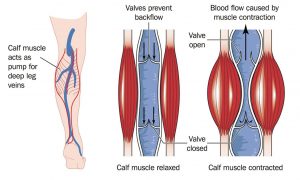 Various forms of venous issues affect 25 million Americans. Their legs are swollen, achy and they have a heavy sensation.
Various forms of venous issues affect 25 million Americans. Their legs are swollen, achy and they have a heavy sensation.
When our veins are working properly, they pump blood back to the heart. Valves in the veins are made to open and close in one direction, if these valves or the wall of the veins are damaged, the blood is unable to work against gravity, and the result is a pooling of the blood in our legs. This pooling is called stasis and can present significant risks to our health.
Sometimes venous insufficiency is more of a cosmetic issue and poses little health concerns. This is usually noted in spider veins, which is when the tiny capillaries are damaged, but when the veins are damaged, this can cause varicose veins, which can lead to a much more severe health issues. Neither of these should be taken lightly. Many people walk around with obvious signs of vein disease while others hide it deeper inside the leg and have no clue of the problem escalating in the legs.
Symptoms of venous insufficiency:
• Swollen legs
• Discoloration on skin (brown or red)
• Tingling/burning/itching sensations
• Heaviness
• Aching
• Cramping
Although it can happen to anyone, the most common factors that put you at risk for vein issues is being a female over the age of 50, pregnancy, sitting for extended periods of time, a family history of varicose veins, smoking, being overweight, and a sedentary lifestyle.
Some people develop ulcerations, or sores on the lower legs and ankles, due to the low level of oxygen in the veins and the uptake of white blood cells. These ulcers and other vein signs can be painLESS or extremely painFUL, resistant to healing and can make one more susceptible for infection and cellulitis
Because the veins and arteries balance each other, when a person has chronic signs and symptoms they most likely can have arterial problems as well. Together, the leg circulation begin to fail exponentially.
Both chronic and acute symptoms could be a sign or lead to a DVT (deep vein thrombosis). DVTs are life-threatening and should be treated immediately. Deep vein thrombosis is a blood clot in the veins that are formed deep in within the legs. Vascular malformations, pelvic tumors or sitting for long periods of time are some of the risk factors that go along with DVTs.
Celebrity and Pro Tennis player Serena Williams suffered a DVT, which led to a pulmonary embolism. Thankfully she had a successful emergency surgery that saved her life. Shortly after having heart surgery, television host, Regis Philbin, also suffered from a DVT. He developed pain in his calf, and after further investigation, the clot was discovered. Fortunately, he too was treated and had a successful outcome.
Every year, over 2 million people are affected by deep vein thrombosis, and sadly over 200,000 of these cases end in death. These are grim statistics since the treatment is minimal and so readily available to patients. Naples Cardiac and Endovascular Center feels a more proactive approach, than a reactive one, could save more lives. Speaking to your medical provider is critical if you or a loved one has any of the above mentions signs or symptoms.
Treatment Options for Venous Insufficiency
• Compression Stockings
• Gradient Compression Devices
• Increased Exercise
• Medications
• Surgery (non invasive thermal and chemical ablation performed in the office)
You have options. Being educated on vascular conditions and the available treatment is to your advantage. At the Naples Cardiac & Endovascular Center we deliver comprehensive heart and vascular care tailored to you.
To Schedule your appointment with
Naples Cardiac and Endovascular Center,
please call (239) 300-0586.
Naples Cardiac and Endovascular Center
(239) 300-0586
www.heartvein.com
1168 Goodlette-Frank Rd N Naples, FL 34102








